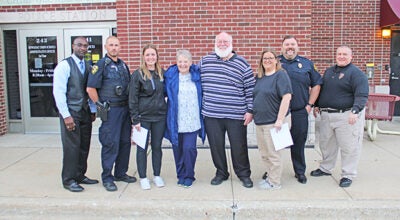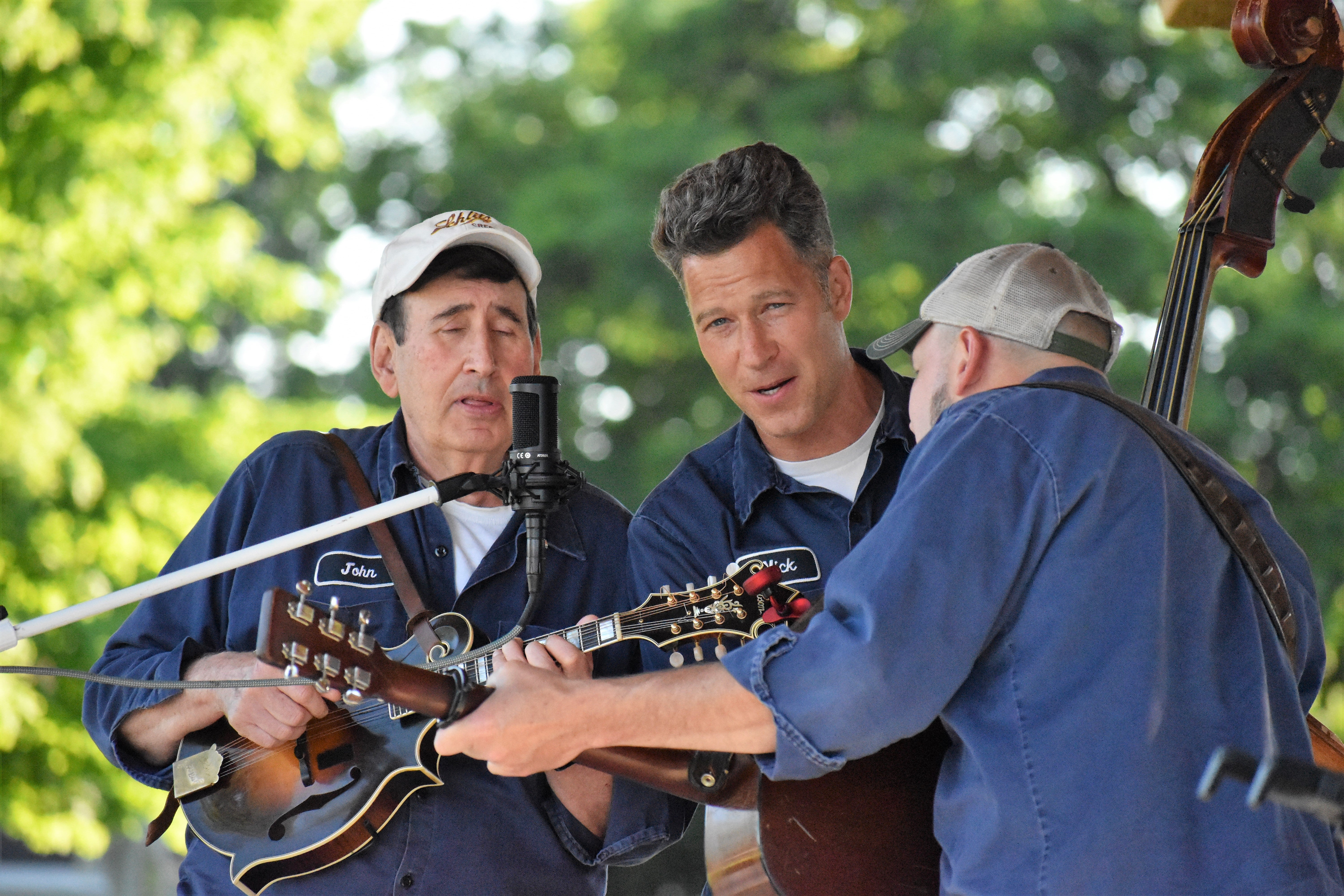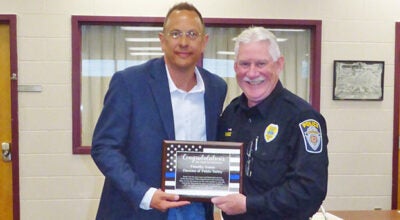Suicide kills more vets than the enemy
Published 9:29 pm Thursday, March 17, 2011
Retired Air Force Maj. Rick Briggs, a “one-man show” for the Brighton-based Brain Injury Association of Michigan, at Southwestern Michigan College Thursday. (The Daily News/John Eby)
After shipping more than a million warriors to the Gulf, at least a third report some kind of issue.
Stateside, returning troops face five major issues, “suicide being paramount,” said retired U.S. Air Force major Rick Briggs, who manages the veterans program of the Brighton-based Brain Injury Association of Michigan — “the only dedicated veterans program in the country.”
“More soldiers have committed suicide since the start of the wars than have been killed by the enemy,” Briggs said Thursday at Southwestern Michigan College. “The same thing we saw in Vietnam; more than 56,000 names are on the Wall. When they came home from Vietnam, anywhere from 120,000 to 240,000 veterans committed suicide post-Vietnam. PTSD (post-traumatic stress disorder) and TBI (traumatic brain injury) are invisible wounds.”
Eighteen veterans a day commit suicide, Army Times reported — “a staggering number,” Briggs said. “That includes all veterans, not just OIF (Operation Iraqi Freedom) and OEF (Operation Enduring Freedom, Afghanistan).
Army Times estimated 950 suicide attempts occur monthly.
Veterans also confront unemployment issues.
“The U.S. Department of Labor identifies traumatic brain injury as the single most significant area to sustained employment. They come back, they get a job, then they lose their job. I know a number of soldiers who are on their fifth or sixth job in six years. I know a young veteran on his sixth job who called me for help. He made sandwiches in a deli and couldn’t remember what meat goes with what cheese,” said Briggs.
He spoke about the 30th anniversary of brain injury rehabilitation, from President Ronald Reagan’s press secretary Jim Brady being shot in the head in March 1981 to the current recovery of U.S. Rep. Gabrielle Giffords, shot in January in Tucson, Ariz.
“The divorce rate, 22 percent is extremely high for a demographic with so many newlyweds and is related a lot to the combat environment,” he said.
“Some of our guys are on their seventh deployment. Homelessness, the fastest-growing population is young veterans, 21 to 29 years old. It’s important to realize that when an individual comes out of combat, for the most part their entire paycheck is tax-free and in the bank, so when they come home, they may have $25,000 to $30,000, yet they wind up homeless. That’s a pretty good start for a 22-year-old.”
On any given night, 131,000 veterans are homeless.
Briggs said an English incarceration report found were more veterans in the criminal justice system than troops deployed in combat. “On parole, in jail, in prison, in court. We’re seeing the exact same thing. You’re not hearing anything about it, but you probably will in the next few months because it’s been drawing a lot of attention.”
“TBI, traumatic brain injury, is the signature wound of the war on terror,” he said. “If you took breast cancer, HIV/AIDS, multiple strokes and spinal cord injury and combined them, then took that number and multiplied by six, that’s how many people are affected by brain injury. The leading cause of death in young people is traumatic brain injury because of automobile accidents.”
In war, the major TBI culprit is IEDs, improvised explosive devices.
“A brain injury affects everything about us and who we are,” said Briggs, who takes beta blockers to manage excruciating headaches associated with a fall on the ice while coaching hockey before helmets were required.
“All the information processed by our micro-processor is affected by a brain injury. I want to differentiate between PTSD and TBI. A traumatic brain injury is a physical assault to the head. Your brain is very soft, the consistency of cooked custard. It doesn’t take much to injure it. That number times six doesn’t include veterans or shaken babies, which is a separate category by itself.
“Ballistic shock waves from IEDs cause massive craters. A hypersonic shock wave goes through your body, which has air pockets, liquid, bone, different tissue densities. Your heart and liver are different densities. As this thing passes through you, it’s twisting and doing damage at the neuron and sub-neuron level. The wonderful news is it’s treatable. Rehabilitation works. Every brain injury is different and everybody responds differently to treatment, but the most important thing with neuro rehab is that you get it done almost immediately” after a few days of rest, which naturally generates chemicals to help with the recovery process.
Given that a brain injury can completely alter someone’s personality, “I’ve had veterans come back whose wives make their favorite meal and they don’t like the way it tastes because his receptors have been modified,” Briggs said.
“The way food tastes has changed. The way her perfume smells is different. Balance, vision, memory, everything the brain does can be changed in a flash.”
TBI symptoms fill a screen as big as the stage in the Lyons Building auditorium, including sadness, dizziness, nervousness, mood swings, balance problems, headaches, irritability, memory loss, numbness, tingling, drowsiness, mental fog, nausea, vomiting and ringing in the ears.
When newsman Bob Woodruff was hit by a rocket-propelled grenade, “He couldn’t tell an airplane from a table,” Briggs said.
“They had to retrain his vocabulary the way you would a child, but it works. He got the best neuro rehab care in the world. Eighteen percent of our soldiers coming out of combat are dealing with TBI, 30 percent with PTSD, a psychological response to stress. It’s not combat-specific. You can get it seeing a little girl hit on a bicycle. There’s a lot of PTSD going on right now in Japan” in the wake of an earthquake, tsunami and nuclear crisis.
In 2001, when terrorists took down the Twin Towers in New York City, the federal government was spending $10 million annually on brain injury research.
“That sounds like a big number, but it averages $1.55 per brain injury per year. You can’t even do a good brochure for that,” Briggs said. “Now we’re putting in hundreds of millions of dollars, and the benefactor is going to be the civilian sector. Sports concussions. The NFL is drawing a boatload of attention. The average life expectancy of a professional football player is 15 years shorter, with four times the national average suicide rate.”
Dave Duerson, 50, a former Notre Dame All-America who won two Super Bowls, including with the 1985 Chicago Bears, died last month at 50 from a self-inflicted gunshot wound to the chest.
He was charged in a domestic dispute in 2005 which led to his divorce and his resignation as a Notre Dame trustee.
His home was foreclosed and he lost a Wisconsin food company.
He texted his family before he took his life and asked that his brain be studied for signs of chronic traumatic encephalopathy, a degenerative brain disease linked to depression and often associated with contact sports.
“It is estimated our cost to society by not treating these issues, PTSD and TBI, will cost us far more, let alone quality of life,” Briggs said. “Only 30 percent of Michigan’s qualified veterans are registered with VA (Veterans Administration). Less than a third, so when you hear a staggering number, you’ve still got to multiply. They cannot solely depend on the DoD (Department of Defense) and VA for mental health. They require outreach programs like the one we’re doing. They can’t do it alone. Substance abuse is going through the roof, with the No. 1 culprit being alcohol. It’s a socially acceptable coping mechanism for not handling the issues of life. If they come home and stop by the American Legion or VFW, the first thing a World War II, Korea or Vietnam veteran says to them is, ‘Let me buy you a drink.’ Worst thing you can do with brain injury — and that from someone who partied a little at MSU. It really does kill brain cells and inhibits the rehabilitation process. Stay away from alcohol, or at least be careful with it.”
The Vietnam veteran’s son served in Iraq.
Briggs said in 2008, the Defense Authorization Act mandated that the federal government provide neurocognitive assessment to create a baseline for performance before deployment.
In 2006-2007 when his son went over, the 182 troops conducted 200 “contact patrols outside the wire. They were shot at every time they went out. They encountered, on average, 12 to 15 IED exposures and it only takes one to ruin your day. That’s what they’re dealing with.
“Post-deployment, the only baseline assessment we have is the wife or mother. Their buddies aren’t going to say anything. We had a young man blown up with a 2,000-pound bomb standing guard outside an Iraqi police station. Shock and awe on TV bombs averaged 500 pounds. It killed 117 Iraqi men, women and children. He was 40 meters away from the blast, but it’s staggering he’s still alive. That much explosive will blow you off your feet at a quarter mile … A chunk of steel from the truck that had been blown skyward came down on his helmet and knocked him back down again. To make matters worse, there were about 100 insurgents and it was a complex attack. He engaged in firefighting for about 2 1/2 hours. He totally ran on adrenaline until at the hospital he collapsed on a cot. We got him into a lot of rehab and two years later he got a 4.0 in college. ‘I never got one before, not in high school, not in anything.’ He learned retraining his brain that he’s not as good as he used to be, but he can be better, so he takes copious notes, pays close attention to the professor, engages in the conversation and highlights everything in the book — what good students do. Before he could glance at material and retain it. Now he has to read things three and four times. It’s tough out there and you have got to make yourself better than everyone else.”
He gives presentations every third day, or 124 a year to an average audience of 129, with the aid of a $50,000 grant.






